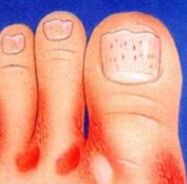According to statistics, all tenth inhabitants of our planet suffer from fungi of the feet or, as it is also called, epidermophytosis. Most often, men suffer from this disease, which is more due to the characteristics of physiology as the fact that male representatives are more often and longer than women, they wear closed shoes.
Mushrooms on the legs: Causes and Risk Factors
The disease can be provoked for the following reasons:

- Inadequate hygiene of the body in general and especially foot;
- Uncomfortable and very close shoes;
- Excessive sweating of the legs;
- Disorders in the work of the human immune system;
- Flat legs and other types of legs;
- Use of public pools and baths;
- Inadequate bathroom hygiene and showers;
- Excess weight;
- Problems of blood circulation in the legs.
General symptoms of foot fungi
The fungi on the legs can be manifested in different ways:
- Inflammation of the skin on the heels and on the legs of the legs;
- Severity of various degrees of itching;
- Cracks;
- Peel.
The exact determination of the type of fungi that impresses the legs will help choose the right treatment for this disease.
Mushrooms on the legs and its types
In medicine, the distribution of 3 main types of fungi is common: membrane, such as McCasin, vesicular. And each of them is inherent in both general and characteristic symptoms.
Signs of membrane fungi:
- Localization in the 4th and 5th branches;
- Characteristic of most fungi - scales;
- Itching.
Mushrooms on moccasin-type legs are different from others:
- The only thickening of the legs;
- Deep cracks;
- Painful sensation;
- Damage to the nails, which, like the skin of the legs, thickens, at the same time gains excessive fragmentation, which can lead to loss of nail plate.

Vesicular fungi are characterized by: blisters filled with fluid and localization at the foot of the foot.
Foot fungi: Diagnosis
The diagnosis of "foot fungi" is made by a dermatologist on the basis of a patient examination. More detailed studies: Scrapers, skin biopsy, cultivation - The doctor will help as well as determine the type of fungi that impresses the patient. In addition to everything, the doctor conducts a patient's survey to detect the disease in the past. The latter is especially important, because the frequent repeated manifestations of fungi for some time indicate the transition to the disease in a more severe form, making it more difficult to treat.
How to treat mushrooms on your feet?
Foot fungal therapy does not require inpatient observation and is performed on an outpatient basis. In most cases, the patient is prescribed external antifungal medications. It is noteworthy that people with fungi often do not go to a specialist at all, restricting themselves for taking drugs sold at the drugstore without a prescription. This scenario often results in a favorable effect on the disease. However, it should be remembered that the prolongation of the disease, which is accompanied by a deterioration of the condition of the legs, indicates the advanced stage of the disease. The best solution to this situation would be to visit a specialist who would help choose the optimal fungus.



























